Vehicle Speed Signal Malfunction (B2282,B2283)
DESCRIPTION
DTC B2282 is
stored when the vehicle speed signal sent by the combination meter
assembly via direct line and the vehicle speed signal sent via CAN
communication do not match.
DTC B2283 is stored when a malfunction in the vehicle speed sensor is detected.
|
DTC No. | Detection Item |
DTC Detection Condition | Trouble Area |
Note |
| B2282 |
Vehicle Speed Signal Malfunction |
The
vehicle speed signal sent by the combination meter assembly via direct
line and the vehicle speed signal sent via CAN communication do not
match. (1-trip detection logic*) |
- Meter/gauge system
- Certification ECU (smart key ECU assembly)
- Wire harness or connector
|
- Drive the vehicle at a vehicle speed of 25 km/h (16 mph) or more for 20
seconds, and then drive the vehicle at a vehicle speed of less than 5
km/h (3 mph) for 20 seconds.
|
| B2283 |
Vehicle Speed Sensor Malfunction |
Either
of the of the following malfunctions is detected (a vehicle speed
sensor malfunction is detected) (1-trip detection logic*):
- Vehicle speed signal malfunction detection 1: Excessive deceleration is detected
- Vehicle speed signal malfunction detection 2: Engine speed linked malfunction detected
|
- Meter/gauge system
- Certification ECU (smart key ECU assembly)
- Wire harness or connector
| DTC Output Confirmation Operation:
- Run the engine at an engine speed of 2000 rpm or more for 300 seconds.
- Drive the vehicle at a vehicle speed of 50 km/h (31 mph) or more for 10
seconds, and then drive the vehicle at a vehicle speed of less than 50
km/h (31 mph).
|
- *: Only detected while a malfunction is present and the engine switch is on (IG).
Vehicle Condition and Fail-safe Function when Malfunction Detected |
DTC Code | Vehicle Condition when Malfunction Detected |
Fail-safe Function when Malfunction Detected |
|
B2282 |
- When the signal sent via either direct line or CAN communication is
malfunctioning and indicates that the vehicle speed is 0 km/h (0 mph),
there is no effect on vehicle behavior.
- When the signal sent via either direct line or CAN communication is
malfunctioning and indicates that the vehicle is moving, the engine
switch cannot be turned from on (IG) to off.
| - |
|
B2283 |
- The power source mode is changed to off (the engine is stopped) by pressing the engine switch while the vehicle is being driven.
- With the electrical key transmitter sub-assembly in the cabin, even if
an engine start operation is performed, the engine will not start.
| Steering lock motor operation is prohibited. |
Related Data List and Active Test Items |
DTC No. | Data List and Active Test |
|
B2282 B2283 | Power Source Control
- Vehicle Speed Signal
- Engine Condition
- Power Supply Condition
Starting Control
Combination Meter
|
WIRING DIAGRAM
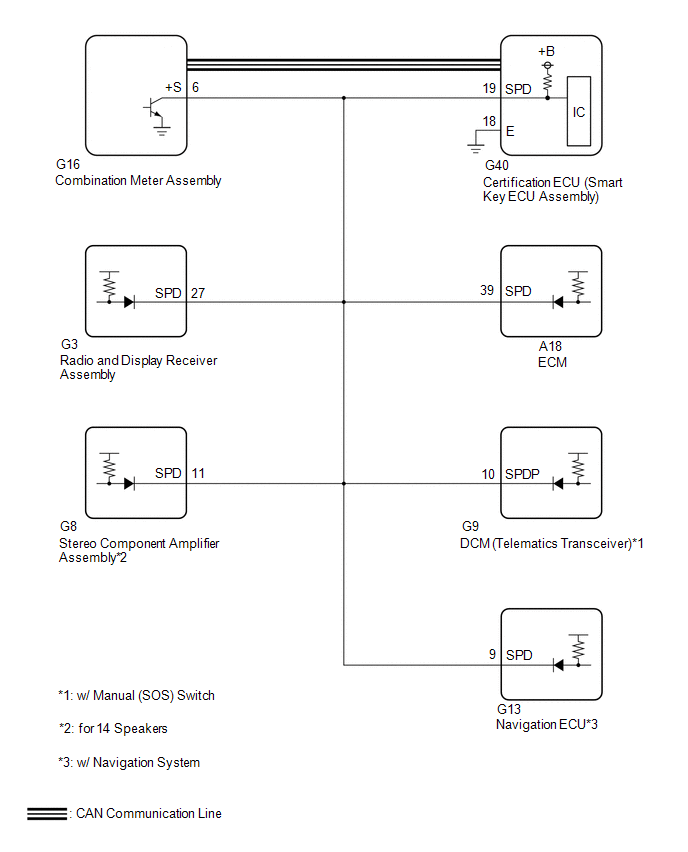
CAUTION / NOTICE / HINT
NOTICE:
- When using the Techstream with the engine switch off, connect the
Techstream to the DLC3 and turn a courtesy light switch on and off at
intervals of 1.5 seconds or less until communication between the
Techstream and the vehicle begins. Then select the vehicle type under
manual mode and enter the following menus: Body Electrical / Smart Key.
While using the Techstream, periodically turn a courtesy light switch on
and off at intervals of 1.5 seconds or less to maintain communication
between the Techstream and the vehicle.
- The smart key system (for Start Function, Gasoline Model) uses the LIN
communication system and CAN communication system. Inspect the
communication function by following How to Proceed with Troubleshooting.
Troubleshoot the smart key system (for Start Function, Gasoline Model)
after confirming that the communication systems are functioning
properly.
Click here 
- Before replacing the certification ECU (smart key ECU assembly), refer to Registration.
Click here 
- After repair, confirm that no DTCs are output by performing "DTC Output Confirmation Operation".
PROCEDURE
|
1. | READ VALUE USING TECHSTREAM (VEHICLE SPEED METER) |
(a) Connect the Techstream to the DLC3.
(b) Turn the engine switch on (IG).
(c) Turn the Techstream on.
(d) Enter the following menus: Body Electrical / Combination Meter / Data List.
(e) Read the Data List according to the display on the Techstream.
Body Electrical > Combination Meter > Data List
|
Tester Display | Measurement Item |
Range | Normal Condition |
Diagnostic Note |
|
Vehicle Speed Meter | Vehicle speed |
Min.: 0, Max.: 255 | Almost same as actual vehicle speed (Speedometer tester) |
- |
Body Electrical > Combination Meter > Data List
|
Tester Display |
| Vehicle Speed Meter |
HINT:
Using a speedometer tester, check the actual vehicle speed and the vehicle speed displayed on the Techstream.
OK:
Vehicle speed displayed on the Techstream is almost the same as the actual vehicle speed measured using a speedometer tester.
| NG |
 | GO TO METER / GAUGE SYSTEM (Speedometer Malfunction) |
|
OK |
 | |
| 2. |
READ VALUE USING TECHSTREAM (VEHICLE SPEED SIGNAL) |
(a) Enter the following menus: Body Electrical / Power Source Control / Data List.
(b) Read the Data List according to the display on the Techstream.
Body Electrical > Power Source Control > Data List
|
Tester Display | Measurement Item |
Range | Normal Condition |
Diagnostic Note |
|
Vehicle Speed Signal | Vehicle being driven or stopped |
Stop or Run | Stop: Vehicle stopped
Run: Vehicle being driven at 5 km/h (3 mph) or more |
- |
Body Electrical > Power Source Control > Data List
|
Tester Display |
| Vehicle Speed Signal |
OK:
The Techstream display changes correctly in response to the vehicle condition.
| OK |
 | GO TO METER / GAUGE SYSTEM (HOW TO PROCEED WITH TROUBLESHOOTING) |
|
NG |
 | |
| 3. |
CHECK HARNESS AND CONNECTOR (CERTIFICATION ECU (SMART KEY ECU ASSEMBLY) - COMBINATION METER ASSEMBLY) |
(a) Disconnect the G16 combination meter assembly connector.
(b) Disconnect the G40 certification ECU (smart key ECU assembly) connector.
(c) Disconnect the A18 ECM connector.
(d) Disconnect the G3 radio and display receiver assembly connector.
(e) Disconnect the G9 DCM (telematics transceiver) connector.*1
(f) Disconnect the G8 stereo component amplifier assembly.*2
(g) Disconnect the G13 navigation ECU.*3
- *1: w/ Manual (SOS) Switch
- *2: for 14 Speakers
- *3: w/ Navigation System
(h) Measure the resistance according to the value(s) in the table below.
Standard Resistance:
|
Tester Connection | Condition |
Specified Condition |
|
G40-19 (SPD) - G16-6 (+S) |
Always | Below 1 Ω |
|
G40-19 (SPD) or G16-6 (+S) - Other terminals and body ground |
Always | 10 kΩ or higher |
| NG |
 | REPAIR OR REPLACE HARNESS OR CONNECTOR |
|
OK |
 | |
| 4. |
CHECK CERTIFICATION ECU (SMART KEY ECU ASSEMBLY) |
(a) Connect the G40 certification ECU (smart key ECU assembly) connector.
(b) Connect the G16 combination meter assembly connector.
(c) Using an oscilloscope, check the waveform.
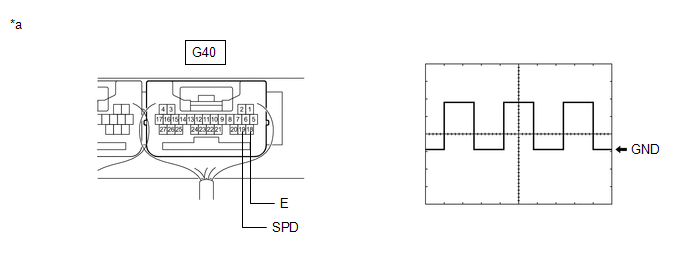
|
*a | Component with harness connected
(Certification ECU (Smart Key ECU Assembly)) |
- | - |
|
Tester Connection | Condition |
Tool Setting | Specified Condition |
|
G40-19 (SPD) - G40-18 (E) | Engine switch on (IG), vehicle being driven at approx. 5 km/h (3 mph) |
5 V/DIV., 20 ms./DIV. |
Pulse generation |
HINT:
The wavelength becomes shorter as the vehicle speed increases.
| OK |
 | REPLACE CERTIFICATION ECU (SMART KEY ECU ASSEMBLY) |
| NG |
 | GO TO METER / GAUGE SYSTEM (Speed Signal Circuit) |
Brake Signal Malfunction (B2284)
DESCRIPTION
This DTC is stored when the brake signal sent via direct line and the brake signal sent via CAN communication do not match.
|
DTC No. | Detection Item |
DTC Detection Condition | Trouble Area |
Note |
| B2284 |
Brake Signal Malfunction |
The brake signal sent via direct line and the brake signal sent via CAN communication do not match. (1-trip detection logic*) |
- Stop light switch assembly
- SFI system
- Certification ECU (smart key ECU assembly)
- Wire harness or connector
|
- Connect the cable to the negative (-) battery terminal, release the
brake pedal and wait at least 20 seconds. Then depress the brake pedal
for 20 seconds or more.
|
- *: Only detected while a malfunction is present and the engine switch is on (IG).
Vehicle Condition and Fail-safe Function when Malfunction Detected |
Vehicle Condition when Malfunction Detected |
Fail-safe Function when Malfunction Detected |
|
With
the electrical key transmitter sub-assembly in the cabin, even if an
engine start operation is performed, the engine does not start (the key
indicator display is not displayed on the multi-information display).
However, the engine can be started by turning the engine switch on (ACC)
and then pressing and holding it.
- If there is a malfunction when the brake signal sent via direct line is
on, the engine can be started by pressing the engine switch with the
brake pedal released.
- If there is a malfunction when the brake signal sent via direct line is
off, the engine cannot be started by pressing the engine switch with the
brake pedal depressed.
| - |
Related Data List and Active Test Items |
DTC No. | Data List and Active Test |
|
B2284 | Power Source Control
Engine
|
WIRING DIAGRAM
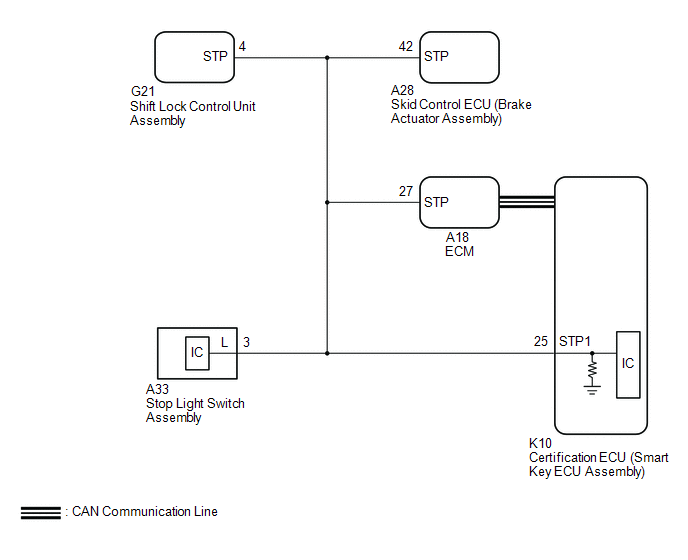
CAUTION / NOTICE / HINT
NOTICE:
- When using the Techstream with the engine switch off, connect the
Techstream to the DLC3 and turn a courtesy light switch on and off at
intervals of 1.5 seconds or less until communication between the
Techstream and the vehicle begins. Then select the vehicle type under
manual mode and enter the following menus: Body Electrical / Smart Key.
While using the Techstream, periodically turn a courtesy light switch on
and off at intervals of 1.5 seconds or less to maintain communication
between the Techstream and the vehicle.
- The smart key system (for Start Function, Gasoline Model) uses the LIN
communication system and CAN communication system. Inspect the
communication function by following How to Proceed with Troubleshooting.
Troubleshoot the smart key system (for Start Function, Gasoline Model)
after confirming that the communication systems are functioning
properly.
Click here 
- Inspect the fuses of circuits related to this system before performing the following procedure.
- Before replacing the certification ECU (smart key ECU assembly), refer to Registration.
Click here 
- After repair, confirm that no DTCs are output by performing "DTC Output Confirmation Operation".
PROCEDURE
|
1. | READ VALUE USING TECHSTREAM (STOP LIGHT SWITCH1) |
(a) Connect the Techstream to the DLC3.
(b) Turn the engine switch on (IG).
(c) Turn the Techstream on.
(d) Enter the following menus: Body Electrical / Power Source Control / Data List.
(e) Read the Data List according to the display on the Techstream.
Body Electrical > Power Source Control > Data List
|
Tester Display | Measurement Item |
Range | Normal Condition |
Diagnostic Note |
|
Stop Light Switch1 | State of brake pedal |
OFF or ON | OFF: Brake pedal released
ON: Brake pedal depressed |
- Use this item to determine if the stop light switch assembly is malfunctioning.
- The engine cannot be started when this item is OFF.
- If the stop light switch assembly is malfunctioning, the engine can be
started by pressing and holding the engine switch for a certain period
of time.
|
Body Electrical > Power Source Control > Data List
|
Tester Display |
| Stop Light Switch1 |
OK:
The Techstream display changes correctly in response to the brake pedal operation.
| OK |
 | GO TO SFI SYSTEM (HOW TO PROCEED WITH TROUBLESHOOTING) |
|
NG |
 | |
| 2. |
CHECK HARNESS AND CONNECTOR (CERTIFICATION ECU (SMART KEY ECU ASSEMBLY) - STOP LIGHT SWITCH ASSEMBLY) |
(a) Disconnect the K10 certification ECU (smart key ECU assembly) connector.
(b) Disconnect the A33 stop light switch assembly connector.
(c) Disconnect the A18 ECM connector.
(d) Disconnect the A28 skid control ECU (brake actuator assembly) connector.
(e) Disconnect the G21 shift lock control unit assembly connector.
(f) Measure the resistance according to the value(s) in the table below.
Standard Resistance:
|
Tester Connection | Condition |
Specified Condition |
|
K10-25 (STP1) - A33-3 (L) |
Always | Below 1 Ω |
| NG |
 | REPAIR OR REPLACE HARNESS OR CONNECTOR |
|
OK |
 | |
| 3. |
CHECK CERTIFICATION ECU (SMART KEY ECU ASSEMBLY) |
(a) Connect the K10 certification ECU (smart key ECU assembly) connector.
(b) Connect the A33 stop light switch assembly connector.
| (c) Measure the voltage according to the value(s) in the table below.
Standard Voltage: |
Tester Connection | Condition |
Specified Condition | |
K10-25 (STP1) - Body ground |
Brake pedal released → depressed |
1 V or less → 9 V or higher | |
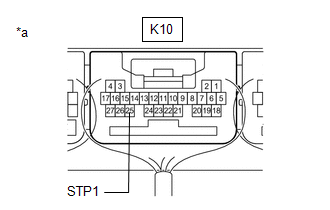 |
|
*a | Component with harness connected
(Certification ECU (Smart Key ECU Assembly)) | | |
| OK |
 | REPLACE CERTIFICATION ECU (SMART KEY ECU ASSEMBLY) |
| NG |
 | REPLACE STOP LIGHT SWITCH ASSEMBLY |
Steering Lock Position Signal Circuit Malfunction (B2285)
DESCRIPTION
This DTC is
stored when the steering lock position signal sent by the steering lock
ECU (steering lock actuator or upper bracket assembly) via direct line
and the steering lock position signal sent via LIN communication do not
match.
|
DTC No. | Detection Item |
DTC Detection Condition | Trouble Area |
Note |
| B2285 |
Steering Lock Position Signal Circuit Malfunction |
The
steering lock position signal sent by the steering lock ECU (steering
lock actuator or upper bracket assembly) via direct line and the
steering lock position signal sent via LIN communication do not match.
(1-trip detection logic*1) |
- LIN communication system
- Steering lock ECU (steering lock actuator or upper bracket assembly)
- Certification ECU (smart key ECU assembly)
- Wire harness or connector
- DCM (telematics transceiver)*2
|
- Disconnect the cable from the negative (-) battery terminal, wait 30
seconds and then reconnect the cable to the negative (-) battery
terminal. Wait at least 40 seconds with the engine switch off (wait is
the steering locked), then turn the engine switch on (IG) (steering
unlocked) and wait at least 40 seconds.
|
- *1: Only detected while a malfunction is present and the engine switch is on (IG).
- *2: for Toyota Entune Remote Connect Compatible Type
Vehicle Condition and Fail-safe Function when Malfunction Detected |
Vehicle Condition when Malfunction Detected |
Fail-safe Function when Malfunction Detected |
|
The engine cannot be started. | The ECU does not send an engine start request. |
Related Data List and Active Test Items |
DTC No. | Data List and Active Test |
|
B2285 | Power Source Control
Smart Key
- Power Supply Short
- Motor Driver Short
- Lock Bar Stuck Error
|
WIRING DIAGRAM
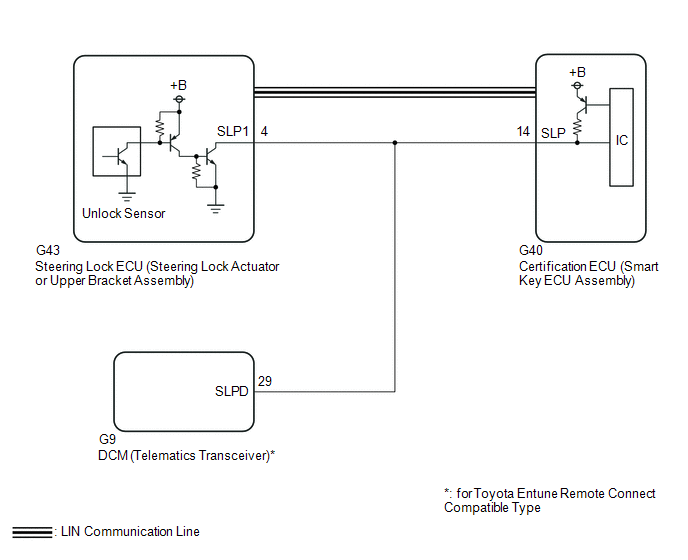
CAUTION / NOTICE / HINT
NOTICE:
- When using the Techstream with the engine switch off, connect the
Techstream to the DLC3 and turn a courtesy light switch on and off at
intervals of 1.5 seconds or less until communication between the
Techstream and the vehicle begins. Then select the vehicle type under
manual mode and enter the following menus: Body Electrical / Smart Key.
While using the Techstream, periodically turn a courtesy light switch on
and off at intervals of 1.5 seconds or less to maintain communication
between the Techstream and the vehicle.
- The smart key system (for Start Function, Gasoline Model) uses the LIN
communication system and CAN communication system. Inspect the
communication function by following How to Proceed with Troubleshooting.
Troubleshoot the smart key system (for Start Function, Gasoline Model)
after confirming that the communication systems are functioning
properly.
Click here 
- Inspect the fuses of circuits related to this system before performing the following procedure.
- Before replacing the certification ECU (smart key ECU assembly),
steering lock ECU (steering lock actuator or upper bracket assembly) or
DCM (telematics transceiver)*, refer to Registration.
Click here 
- *: for Toyota Entune Remote Connect Compatible Type
- After repair, confirm that no DTCs are output by performing "DTC Output Confirmation Operation".
PROCEDURE
(a) Check for DTCs.
Body Electrical > Smart Key > Trouble Codes
HINT:
- If the steering cannot be unlocked, the engine switch cannot be turned on (IG) and the engine cannot be started.
- If LIN communication is not available, the steering cannot be locked or unlocked.
OK:
LIN communication system DTC B2785 is not output simultaneously.
| NG |
 | GO TO DTC B2785 |
|
OK |
 | |
| 2. |
READ VALUE USING TECHSTREAM (STEERING UNLOCK SWITCH) |
(a) Connect the Techstream to the DLC3.
(b) Turn the engine switch on (IG).
(c) Turn the Techstream on.
(d) Enter the following menus: Body Electrical / Power Source Control / Data List.
(e) Read the Data List according to the display on the Techstream.
Body Electrical > Power Source Control > Data List
|
Tester Display | Measurement Item |
Range | Normal Condition |
Diagnostic Note |
|
Steering Unlock Switch |
State of steering unlock sensor signal output from steering lock ECU (steering lock actuator or upper bracket assembly) |
OFF or ON | OFF: Steering locked
ON: Steering unlocked |
- When the shift lever is in P and the engine switch is off, if any door is opened or closed, the steering is locked.
- When the electrical key transmitter sub-assembly is in the cabin and the
engine switch is turned on (ACC) or on (IG), the steering unlocks.
- The engine cannot be started when the steering unlock signal is off.
|
Body Electrical > Power Source Control > Data List
|
Tester Display |
| Steering Unlock Switch |
OK:
The Techstream display changes.
| OK |
 | REPLACE STEERING LOCK ECU (STEERING LOCK ACTUATOR OR UPPER BRACKET ASSEMBLY) |
|
NG |
 | |
| 3. |
CHECK STEERING LOCK ECU (STEERING LOCK ACTUATOR OR UPPER BRACKET ASSEMBLY) |
| (a) Measure the resistance according to the value(s) in the table below.
Standard Resistance: |
Tester Connection | Condition |
Specified Condition | |
G43-4 (SLP1) - Body ground |
Positive (+) tester probe → G43-4 (SLP1) Negative (-) tester probe → Body ground |
Steering locked → unlocked* |
10 kΩ or higher → Below 1 Ω |
HINT:
- *: If any of the doors are opened with the shift lever in P and the
engine switch off, the steering will be locked. If the engine switch is
turned on (ACC) or on (IG) with the electrical key transmitter
sub-assembly in the cabin, the steering will be unlocked.
- DTC B2285 may be stored due to a malfunction in the steering lock ECU
(steering lock actuator or upper bracket assembly). The steering lock
position signal and unlock position signal are sent from the steering
lock ECU (steering lock actuator or upper bracket assembly) to the
certification ECU (smart key ECU assembly) individually.
|
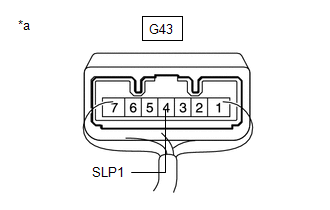 |
|
*a | Component with harness connected (Steering Lock ECU (Steering Lock Actuator or Upper Bracket Assembly)) | | |
|
Result | Proceed to |
|
OK (except Toyota Entune Remote Connect Compatible Type) |
A |
| OK (for Toyota Entune Remote Connect Compatible Type) |
B |
| NG |
C |
| B |
 | GO TO STEP 5 |
| C |
 | REPLACE STEERING LOCK ECU (STEERING LOCK ACTUATOR OR UPPER BRACKET ASSEMBLY) |
|
A |
 | |
| 4. |
CHECK
HARNESS AND CONNECTOR (CERTIFICATION ECU (SMART KEY ECU ASSEMBLY) -
STEERING LOCK ECU (STEERING LOCK ACTUATOR OR UPPER BRACKET ASSEMBLY)) |
(a) Disconnect the G40 certification ECU (smart key ECU assembly) connector.
(b) Disconnect the G43 steering lock ECU (steering lock actuator or upper bracket assembly) connector.
(c) Measure the resistance according to the value(s) in the table below.
Standard Resistance:
|
Tester Connection | Condition |
Specified Condition |
|
G40-14 (SLP) - G43-4 (SLP1) |
Always | Below 1 Ω |
|
G40-14 (SLP) or G43-4 (SLP1) - Other terminals and body ground |
Always | 10 kΩ or higher |
| OK |
 | REPLACE CERTIFICATION ECU (SMART KEY ECU ASSEMBLY) |
| NG |
 | REPAIR OR REPLACE HARNESS OR CONNECTOR |
| 5. |
CHECK
HARNESS AND CONNECTOR (CERTIFICATION ECU (SMART KEY ECU ASSEMBLY) -
STEERING LOCK ECU (STEERING LOCK ACTUATOR OR UPPER BRACKET ASSEMBLY) -
DCM) |
(a) Disconnect the G40 certification ECU (smart key ECU assembly) connector.
(b) Disconnect the G43 steering lock ECU (steering lock actuator or upper bracket assembly) connector.
(c) Disconnect the G9 DCM (telematics transceiver) connector.
(d) Measure the resistance according to the value(s) in the table below.
Standard Resistance:
|
Tester Connection | Condition |
Specified Condition |
|
G40-14 (SLP) - G43-4 (SLP1) |
Always | Below 1 Ω |
|
G43-4 (SLP1) - G9-29 (SLPD) |
Always | Below 1 Ω |
|
G40-14 (SLP), G43-4 (SLP1) or G9-29 (SLPD) - Other terminals and body ground |
Always | 10 kΩ or higher |
(e) Measure the voltage according to the value(s) in the table below.
Standard Voltage:
|
Tester Connection | Condition |
Specified Condition |
|
G40-14 (SLP), G43-4 (SLP1) or G9-29 (SLPD) - Body ground |
Always | Below 1 V |
| NG |
 | REPAIR OR REPLACE HARNESS OR CONNECTOR |
|
OK |
 | |
| 6. |
CHECK CERTIFICATION ECU (SMART KEY ECU ASSEMBLY) |
(a) Check the push-button start function.
(1) Enter the vehicle while carrying an electrical key transmitter sub-assembly.
(2) Depress the brake pedal with the shift lever in P.
(3) Check that the engine starts when the engine switch is pressed.
|
Result | Proceed to |
|
Engine starts | A |
|
Engine does not start |
B |
| A |
 | REPLACE DCM (TELEMATICS TRANSCEIVER) |
| B |
 | REPLACE CERTIFICATION ECU (SMART KEY ECU ASSEMBLY) |






































